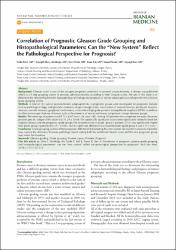Correlation of Prognostic Gleason Grade Grouping and Histopathological Parameters: Can the "New System" Reflect the Pathological Perspective for Prognosis?
Abstract
Background: Gleason score is one of the strongest prognostic predictors of prostate cancer; however, a change was published which is a 5 step grouping system of prostatic adenocarcinomas according to their Gleason scores. The aim of this study is to determine the relationship between histopathological findings and prognosis of tumors subgrouped according to the new Gleason grade grouping system. Methods: A total of 163 radical prostatectomies subgrouped into 5 prognostic groups were investigated for prognostic features such as pathological stage, extraprostatic extension, surgical margin status, involvement of seminal vesicles, perineural invasion, necrosis, vascular invasion, ganglionic involvement, concomitant high grade prostatic intraepithelial neoplasia (HPIN) in addition to other microscopic features of tumors such as the presence of mucin and foamy cytoplasmic change between groups. Results: The mean age of patients was 65.72 +/- 6.67 (min = 46, max = 82). Among 131 patients who completed the study, the mean prostate specific antigen (PSA) value was 11.29 +/- 10.88. The statistically significant factors were significantly related to both the original Gleason and the prognostic grade groups. The recurrence rate of grade group 4 patients (57%) was significantly higher than grade group 3 patients (8%) (P = 0.038). But no significant difference was found between grade group 4 and 5 (P = 0.25). Conclusion: Grade grouping systems reflect prognostic differences but adapting this new system into routine evaluation of patients may confuse the clinicians; however, pathology reports stating both the traditional Gleason score and the new prognostic group may soften the transition.


















